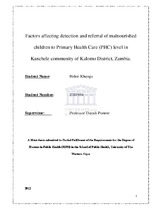| dc.contributor.advisor | Puoane, Thandi | |
| dc.contributor.author | Khunga, Helen | |
| dc.date.accessioned | 2015-09-07T22:32:40Z | |
| dc.date.available | 2015-09-07T22:32:40Z | |
| dc.date.issued | 2012 | |
| dc.identifier.uri | http://hdl.handle.net/11394/4508 | |
| dc.description | Magister Public Health - MPH | en_US |
| dc.description.abstract | Background: Malnutrition in children under the age of 5 years is a global public Health problem. The UNICEF report states that 10.9 million children under five die in developing countries each year due to malnutrition. According to the Zambia Demographic and Health Survey of 2008 malnutrition is one of the main childhood illnesses in Zambia with almost 50% of the under five children being stunted. The referral system in Zambia is organized in a way that starts at the Primary Health Care (PHC) level within the community and managed by the Community Health Workers (CHW). At this level, Community Health Workers screen and identify children that have childhood illnesses which require treatment and they refer them to the Rural Health Centre (RHC). When the problem cannot be handled at the RHC level the child is referred to the district hospital or provincial hospital level within a particular province. However, most children with malnutrition arrive late at the hospital for treatment. Some of them die soon after admission. It was not clear what prevent the mothers from bringing these children early to the hospital for treatment. Methods: The main aim of the study was to explore factors that are associated with detection and referral of malnourished children from Primary Health Care (PHC) at community level to the Health centres in Kalomo district. The study was conducted in Kanchele community of Kalomo in Southern Province of Zambia. Kanchele is a rural community with most basic services such as health facilities not being easily accessed. The study focused on two PHCs which had the highest prevalence of malnutrition. All participants were asked to sign a consent form after the purpose of study had been explained to them. They were informed that all information would be treated with confidentiality and that participation was voluntary and that they had the right to chose not to participate in the study. Furthermore each participant was asked if they agreed to maintain the confidentiality of the information discussed by participants and researchers during the focus group session. The study was qualitative in nature and focus group discussions were conducted with mothers or caregivers of children under five years, community members who have lived in the community for more than one year and community health workers who have also worked in the community for more than one year. Focus group discussions were used to collect data from mothers and community members. While in-depth interviews were used to collect data from CHWs and nutrition group leaders working at the PHC and community leaders. The data collected from the focus group discussions was analysed using thematic approach. Barriers or hindrances to rehabilitating a malnourished child mentioned by the respondents included lack of knowledge on malnutrition, failure to link malnutrition to poor feeding and bad health seeking habits, poor response to referral as a result of a system which is not supported with adequate resource such as transport, a system that does not support parents with food in-case of the child being hospitalised, the current hospital system only provides food to the patient. The failure by health staff to see that malnutrition is a key childhood disease. Data from this study will be used to develop interventions to improve the management of malnourished children. Conclusion: The study shows that mothers and community members are misinformed about the causes and treatment of malnutrition. It also clearly showed that traditional healers and grandparents played an important role in the diagnosis and treatment of malnourished children in this community. Interventions to improve identification and referral of these malnourished children needs to taken into consideration. | en_US |
| dc.language.iso | en | en_US |
| dc.publisher | University of the Western Cape | en_US |
| dc.subject | Malnutrition | en_US |
| dc.subject | Referral system | en_US |
| dc.subject | Community health workers | en_US |
| dc.subject | Mothers | en_US |
| dc.title | Factors affecting detection and referral of malnourished children to Primary Health Care (PHC) level in Kanchele community of Kalomo District, Zambia | en_US |
| dc.type | Thesis | en_US |
| dc.rights.holder | University of the Western Cape | en_US |

